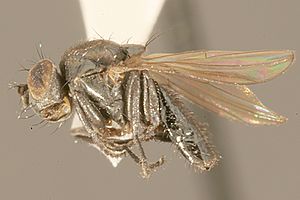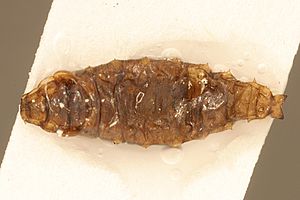Helaeomyia petrolei facts for kids
Quick facts for kids Helaeomyia petrolei |
|
|---|---|
 |
|
| Scientific classification | |
| Kingdom: | |
| Phylum: | |
| Class: | |
| Order: | |
| Family: |
Ephydridae
|
| Genus: |
Helaeomyia
|
| Species: |
H. petrolei
|
| Binomial name | |
| Helaeomyia petrolei (Coquillett, 1899)
|
|
| Synonyms | |
|
Psilopa petrolei |
|
The petroleum fly, also known as Helaeomyia petrolei, is a special type of fly. It lives in California, USA. What makes this fly so unique is where its young, called larvae, grow up. They live and feed in natural pools of crude oil!
This is amazing because crude oil is usually very harmful to insects. But the petroleum fly is the only known insect species that can develop in this toxic substance. Its larvae eat dead insects and other small creatures that get stuck in the oil.
Contents
What Does the Petroleum Fly Look Like?
Adult petroleum flies are quite small, usually about 5 mm long. That's about the length of a small pea! Their bodies are mostly black. They have lighter colored cheeks.
Their wings are clear but have a gray tint, especially on the front half. They also have small, yellowish balancing organs called halteres with white tips. Their eyes are quite hairy and are closest together in the middle of their face.
Life Cycle and How They Survive in Oil
The larvae of the petroleum fly spend almost their entire lives in crude oil. They usually swim slowly near the surface. You can often see the tips of their breathing tubes just above the oil. However, they can also go underwater for longer times if needed.
Scientists don't know much about how these flies mate or lay their eggs. It's thought that the eggs are not laid directly in the oil. When the larvae are ready to change into adult flies, they leave the oil. They travel to nearby grass stems at the edge of the oil pool to become pupae.
How Do They Tolerate Petroleum?
Petroleum fly larvae actually eat a lot of oil and asphalt. If you look closely, you can see their guts are full of it! But they don't get their food from the oil itself. Instead, they eat the dead animals that get trapped in the oil. They are very quick to devour this animal matter.
The oil pools can get quite warm, sometimes up to 38 degrees Celsius (100 degrees Fahrenheit). But the larvae are not harmed by this heat. They can even survive in the lab when mixed with strong chemicals like turpentine or xylene.
Scientists are very interested in these larvae. Their guts contain about 200,000 types of heterotrophic bacteria. These bacteria are special because they can live in an environment with organic solvents like oil. The larvae's gut provides a good home for these bacteria, with a pH of about 6.5. However, there's no clear proof that these bacteria help the fly itself.
A famous scientist named William Homan Thorpe once called the petroleum fly "undoubtedly one of the chief biological curiosities of the world." This shows how truly unique and amazing this insect is!
Where Can You Find the Petroleum Fly?
The petroleum fly was first officially described in the crude oil of the La Brea Tar Pits. These famous tar pits are located near Los Angeles, California. Even before scientists officially named the fly, people who worked with petroleum knew about these "maggots" in the oil.
Today, the population of petroleum flies is not considered to be in danger. They have been found in other places too, but their presence in these other locations is usually not as common.
Images for kids
See also
 In Spanish: Mosca del petróleo para niños
In Spanish: Mosca del petróleo para niños




